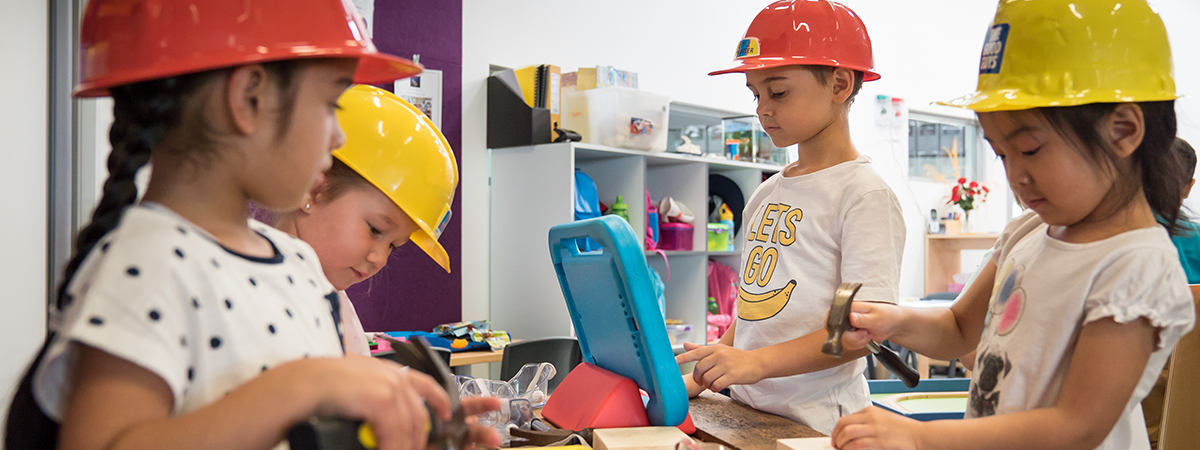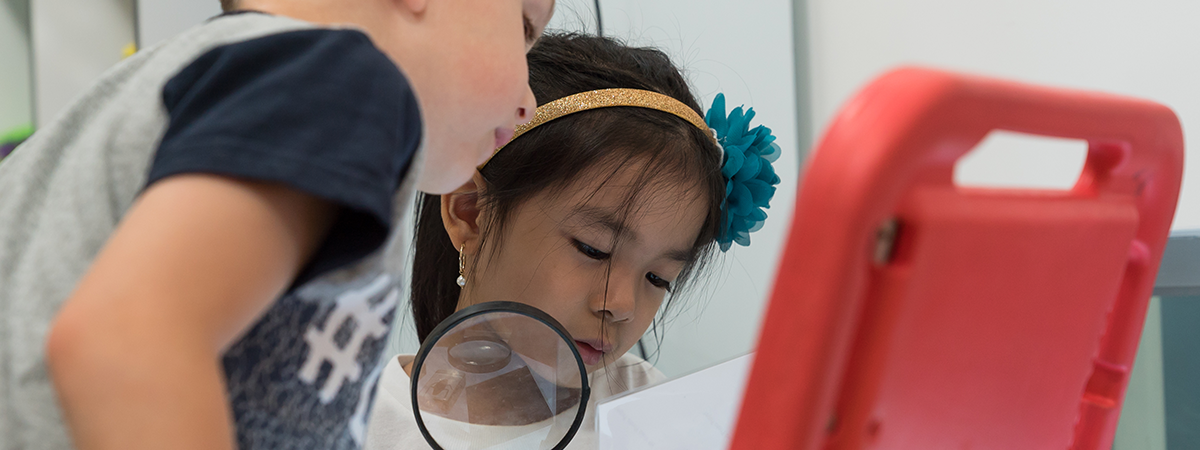By Amanda Macdonald | 4 Feb, 2021

Educators are increasingly thinking about how to provide technologies in ways that support children's play and cultural understandings. Appropriate use of technology balances and enhances the use of other learning materials, activities, and interactions in the preschool and can expand young children's access to new content. When educators use a combination and diversity of activities and learning materials, digital and traditional play can stimulate children's imagination and social interaction. As we have all seen during the COVID-19 pandemic of 2020, technologies used carefully can also provide valuable support to children, their families, and educators in times of stress and isolation.
The use of technology in early childhood can promote effective learning and development when used intentionally within the framework of developmentally appropriate practice (National Association for the Education of Young Children, 2009). Enjoyable shared experiences with apps that optimise the potential for children's learning and development can support children's relationships both with adults and their peers.
The Early Learning Languages Australia (ELLA) program is a good example of how this can be realised. It supports educators by providing resources, materials, and ideas to use alongside a series of play-based apps to encourage children to develop their creativity and imagination. Importantly, technology can expand young children's access to new content (Guernsey, 2010), as ELLA does by exposing children to interactive language experiences.
As outlined in the Statement on Young Children and Digital Technologies, published by Early Childhood Australia (2018), educators must consider their own attitudes and values in understanding the role and use of digital technologies in early childhood education. It is important to use technology in a collaborative and social way. A good question to ask is: Will the technology enhance this experience?
It is evident that educators participating in the ELLA program demonstrate skill in recognising the language learning benefits that come from blending the concepts of the ELLA apps into the imaginative play spaces of their preschool rooms. The tablet device becomes a resource to support collaboration and social play. Educators become co-learners with the children; they collaborate to build hands-on experiences that augment and/or complement the digital world. The technology enhances learning as children demonstrate and consolidate their understanding through their interactions with others. It becomes part of the daily routine (Kaufman et al, 2017; Seater, Ellis & Railsback, 2001).
Siraj-Blatchford and Brock (2016) say that the use of developmentally appropriate early childhood educational technology successfully balances both on- and off-screen activities to integrate both digital and non-digital play in the curriculum. To benefit young children, technology should be used to support learning; it should not be an isolated activity. Educators have long moved on from the notion of providing timed doses of computer use before children get back to the real business of hands-on play. Combining both digital and traditional play can stimulate children's imagination, so apps that allow children to use their imagination and to explore their creativity are most likely to support children's learning outcomes (Verenikina & Kervin, 2011).
Educators need to explore apps that allow the children to do things that they otherwise could not. Apps that allow children to make use of the camera and microphones to record their world, and the gyroscope and audio output to manipulate and explore items on screen, add extra dimensions to the learning experience. Touch-screen devices can be used to learn about the world outside our immediate community, to motivate children to practise skills, and to share their understandings with others.

For some children, technology allows greater participation in the preschool play program. By bringing the tablet device into coexistence with other items in their physical environment, children participate in language development in a way that would otherwise not be available to them (Dezuanni & Knight, 2015).
Children with language delays can find new ways to practise listening and speaking. Children who find it difficult to play alongside others may find that the technology provides a focus, and a model, for joining social play. Bird (2017) believes that the first step when implementing digital technologies is to understand how children engage with them in various forms and to provide technologies in ways that support children's play and cultural understandings.
Early childhood teachers have great skill in observing learning and extending, scaffolding, and transferring children's skills. Digital technologies are becoming accepted as an important part of the early childhood curriculum (Nuttall et al, 2015), and many educators embrace the concept of digital play. This was particularly evident when teachers quickly moved online to deliver preschool programs for children at home during the COVID-19 pandemic of 2020. During this time, the focus was on connections. As outlined in the Statement on Young Children and Digital Technologies (2018), digital technologies can be used to support positive child-adult relationships. Children are encountering digital technology in all aspects of their lives, so preschool should be no different (Bird, 2017). During the pandemic, families appreciated digital technologies as a way to stay in touch.
Katlyn, a kindergarten teacher in Brisbane, reached out to families:
‘We tried to make phone calls to all the class members' families. We were disheartened when we did not have a huge response, including one parent who later replied that they never answer phone calls.’
However, she found that FaceTime chats worked well with the children and families.
In Rockhampton, Julia had a similar experience:
‘How to stay connected with our children and families during COVID-19 was our biggest concern. We brainstormed lots of ideas and came up with a few options, one being a daily Zoom session lasting about 20 minutes. We thought this was important so the children could still see our faces and those of their friends. It also enabled us to continue their regular routine of a group session at this time.’
Both Katlyn and Julia believe that it helped the transition back to preschool. ‘We are now back at kindy with our full crew, with new challenges. As the children have been seeing us each week and talking to us, they have settled excitedly back into the kindy program.’ They feel the technology allowed the contact necessary to maintain the children 's sense of belonging. ‘Transitioning back to face-to-face learning during Week 4 of Term 2 has run relatively smoothly as we were able to keep in contact.’

A technology should be used as you would use any other resource – as an integrated way to support and extend the play and education of young children. Technology allows us to connect with others and explore learning and teaching in new ways.
Bird, J. (2017). Children's responses to working and non-working digital technologies. In L. Arnott (Ed.), Digital technologies and learning in the early years (pp.101-113). Sage Publications.
Dezuanni, M. & Knight, L. (2015). Networking iPads into preschool spaces. In M. Dezuanni, K. Dooley, S. Gattenhof, & L. Knight (Eds.), iPads in the early years: Developing literacy and creativity (pp.142-160). Routledge.
Early Childhood Australia. (2018). Statement on young children and digital technologies. Retrieved from Early Childhood Australia website: http://dx.doi.org/10.23965/ECA.001
Guernsey, L. (2010, August 1). Screens, kids, and the NAEYC position statement. Retrieved from New America website: https://www.newamerica.org/education-policy/early-elementary-education-policy/early-ed-watch/screens-kids-and-the-naeyc-positionstatement
Kaufman, J., Leung, S., Perry, C., Tarasuik, J., Highfield, K., Guy, J., & the Swinburne Babylab team. (2017). Evaluation of the early learning languages Australia apps: Final report to the Australian Government Department of Education and Training. Swinburne University of Technology.
National Association for the Education of Young Children (NAEYC). (2009). Developmentally
appropriate practice in early childhood programs serving children from birth through age 8. Retrieved from https://www.naeyc.org/sites/default/files/globally-shared/downloads/PDFs/resources/positionstatements/PSDAP.pdf
Nuttall, J., Edwards, S., Mantilla, A., Grieshaber, S. & Wood, E. (2015). The role of motive objects in early childhood teacher development concerning children's digital play and play-based learning in early childhood curricula. Professional Development in Education, 41(2), 222-235.
Seater, J., Ellis, D. & Railsback, J. (2001). Technology in early childhood education. Northwest Regional Educational Laboratory.
Siraj-Blatchford, J. & Brock, L. (2016). Early childhood digital play and the Zone of Proximal Developmental Flow (ZPDF). In Proceedings I Congreso Internacional de lnnovacion Y Tecnologia Educativa en Educacion lnfantil, Seville.
Verenikina, I. & Kervin, L. (2011). iPads, digital play and pre-schoolers. He Kupu, 2(5), 4-19.